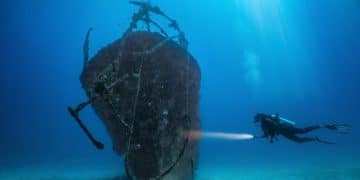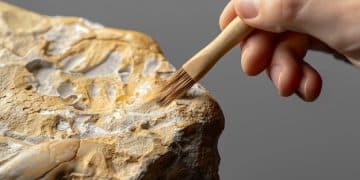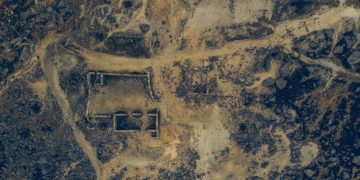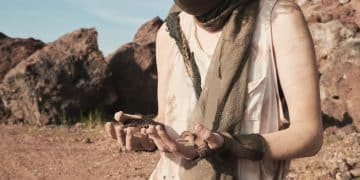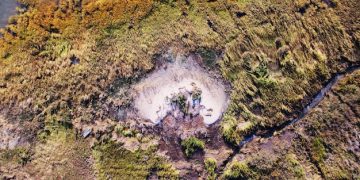Future of Archaeological Preservation: $5M Grant Boosts Innovation
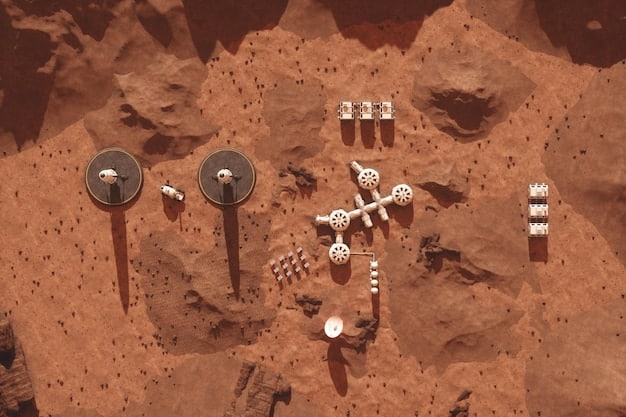
A new $5 million grant is set to revolutionize archaeological preservation across the US by funding innovative conservation techniques, addressing challenges posed by climate change and development, and ensuring the protection of invaluable cultural heritage for future generations.
The field of archaeology is constantly evolving, driven by new discoveries and the urgent need to protect our shared human heritage. Today, a significant development is poised to transform how we approach this critical mission:
Understanding the Urgency: Why Archaeology Needs Innovation
Archaeological sites are non-renewable resources, each one a unique manuscript of human history. Once disturbed or destroyed, their irreplaceable information is lost forever. The urgency to preserve these sites has never been greater, as they face unprecedented threats from various sources.
Traditional preservation methods, while foundational, often struggle to keep pace with these escalating challenges. Climate change, in particular, is accelerating the degradation of sites through increased erosion, rising sea levels, and extreme weather events. Urban expansion and agricultural intensification also lead to direct destruction, further emphasizing the need for more adaptable and resilient conservation strategies.
Escalating Threats to Cultural Heritage
The sheer volume and diversity of archaeological sites in the US present a monumental preservation challenge. From ancient indigenous villages to colonial settlements and industrial landscapes, each site tells a part of the American story. However, many are vulnerable, lying exposed to elements that relentlessly erode their integrity.
- Climate Change Impacts: Rising sea levels threaten coastal sites, while increased wildfires and floods endanger inland heritage.
- Urban and Agricultural Development: Construction and land-use changes frequently lead to the accidental or deliberate destruction of buried sites.
- Looting and Vandalism: Illicit activities continue to damage sites, removing artifacts from their context and destroying valuable historical data.
- Limited Resources: Despite the intrinsic value of archaeological heritage, funding and personnel for preservation efforts often remain scarce.
The Role of Proactive Conservation
Moving beyond reactive measures to proactive conservation is essential. This new grant aims to shift the paradigm from merely mitigating damage to actively anticipating and preventing it. Such a forward-thinking approach involves both on-site stabilization and off-site measures, focusing on long-term sustainability rather than temporary fixes.
The goal is to implement solutions that are not only effective in the short term but also adaptable to future environmental and societal changes. This requires a deeper understanding of material science, environmental dynamics, and community engagement, integrating them into a holistic preservation strategy.
Ultimately, the success of archaeological preservation hinges on our ability to innovate and collaborate effectively. The grant serves as a catalyst, encouraging new partnerships between academic institutions, government agencies, local communities, and private organizations to pool expertise and resources. This collaborative spirit is vital for tackling the multifaceted challenges ahead and ensuring that our shared past remains accessible for generations to come.
Beyond the Shovel: Embracing Cutting-Edge Technologies
The era of archaeology relying solely on the shovel and trowel is rapidly evolving. The new $5 million grant is strategically allocated to push the boundaries of traditional archaeological practices by integrating cutting-edge technologies. This shift acknowledges that modern problems require modern solutions, enabling more efficient, non-invasive, and effective preservation efforts.
This technological embrace extends from initial site discovery and documentation to long-term monitoring and conservation. Innovations in remote sensing, material analysis, and digital modeling are particularly promising, offering new avenues for understanding and safeguarding cultural heritage. The goal is not to replace human expertise but to augment it, providing archaeologists with powerful tools to enhance their work.
Remote Sensing and Non-Invasive Prospection
One of the most impactful applications of new technology lies in non-invasive prospection. Instead of extensive excavation, archaeologists can now use advanced remote sensing techniques to map and understand sites beneath the surface. This minimizes disturbance, preserving the integrity of the site while still gaining invaluable data.
- LiDAR (Light Detection and Ranging): Essential for revealing hidden features in forested or heavily vegetated areas by penetrating foliage.
- Ground-Penetrating Radar (GPR): Used to detect subsurface anomalies, indicating buried structures, foundations, or features without excavation.
- Magnetometry and Electrical Resistivity: Provide insights into buried archaeological features based on variations in the Earth’s magnetic field or electrical conductivity.
- Drone Imagery and Photogrammetry: Offer high-resolution aerial views and 3D models of sites, aiding in documentation and monitoring changes over time.
Advanced Material Analysis and Preservation Science
Understanding the degradation processes of artifacts and structures is crucial for effective preservation. The grant supports research into advanced material analysis, which can inform tailored conservation strategies. This involves a deeper dive into the chemical and physical properties of archaeological materials.
For instance, micro-CT scans can reveal the internal structure of delicate artifacts without causing damage, while molecular analysis can identify the precise composition of ancient organic materials. This scientific approach allows conservators to predict decay, develop new stabilization agents, and create environmental controls that extend the lifespan of artifacts and structures. The emphasis is on developing sustainable preservation methods that consider the long-term interaction between materials and their environment, minimizing the need for constant human intervention.
Furthermore, digital preservation techniques, such as 3D scanning and virtual reality reconstructions, are becoming increasingly important. They create detailed digital archives of sites and artifacts, providing a permanent record even if the physical remains are lost. These digital assets are not only for academic research but also for public engagement, allowing broader access to cultural heritage that might otherwise be inaccessible. This fusion of traditional archaeological principles with cutting-edge scientific and digital tools ensures a comprehensive approach to preserving the past for the future.

Community Engagement and Indigenous Partnerships
Effective archaeological preservation extends far beyond excavation and scientific analysis; it deeply intertwines with community values and cultural identities. The new $5 million grant significantly emphasizes the necessity of robust community engagement and, critically, meaningful partnerships with indigenous peoples. This approach acknowledges that the true stewards of cultural heritage are often the communities whose ancestors created it.
By empowering local groups and respecting Indigenous sovereignty, preservation efforts become more sustainable, ethical, and culturally relevant. This shift moves away from a purely academic or governmental top-down approach to a collaborative framework, recognizing that shared ownership leads to stronger outcomes. Such partnerships are vital for ensuring that preservation is not just about physical sites but also about living cultures and oral traditions.
Empowering Local Stakeholders
Community involvement brings invaluable local knowledge and strengthens the bond between heritage sites and the people who live near them. The grant supports initiatives that train local community members in preservation techniques, site monitoring, and documentation. This capacity building ensures that conservation efforts can continue long after initial project funding ceases.
- Training Programs: Educating local residents in basic archaeological methods, site identification, and reporting of damage or discoveries.
- Volunteer Networks: Establishing organized groups of community volunteers for site clean-up, monitoring, and educational outreach.
- Collaborative Planning: Involving local councils and community leaders in the decision-making process for preservation projects.
- Heritage Tourism Development: Supporting initiatives that allow communities to benefit economically from their heritage sites, fostering a vested interest in their protection.
Centering Indigenous Voices in Preservation
For countless archaeological sites in the US, indigenous peoples are the direct descendants, holding profound ancestral connections and traditional ecological knowledge. The grant prioritizes partnerships that recognize tribals’ inherent rights and their unique perspectives on heritage preservation. This means going beyond consultation to true collaboration and co-management.
This includes supporting tribal nations in their own preservation efforts, funding tribal heritage offices, and ensuring that archaeological research conducted on ancestral lands respects cultural protocols and intellectual property rights. By sharing leadership and resources, these partnerships ensure that preservation is carried out in a way that is culturally appropriate, respectful of sacred sites, and contributes to the ongoing vitality of indigenous cultures. It is about recognizing that indigenous knowledge systems offer profound insights into land use, resource management, and long-term sustainability that are invaluable to modern conservation challenges. This collaborative model fundamentally transforms how archaeological sites are managed, moving towards a more just and equitable future for heritage conservation.
Adapting to a Changing Climate: Resilient Preservation Strategies
Climate change poses perhaps the most significant and rapidly evolving threat to archaeological sites worldwide. From coastlines to mountains, ancient remnants of human activity are increasingly vulnerable to rising sea levels, extreme weather events, increased erosion, and changes in temperature and precipitation patterns. The $5 million grant explicitly targets the development and implementation of resilient preservation strategies designed to counter these climatic impacts across the US.
This isn’t merely about protecting sites from the immediate effects of a storm; it’s about developing long-term, sustainable solutions that anticipate future changes. It requires integrating climate science with archaeological practice, creating adaptive management plans, and fostering innovation in engineering and environmental conservation. The ultimate goal is to minimize the loss of irreplaceable cultural heritage due to environmental shifts that are already underway.
Mitigating Coastal Erosion and Sea-Level Rise
Coastal archaeological sites, particularly those along the increasingly vulnerable shorelines of the US, face imminent destruction from rising sea levels and storm surges. Preservation efforts in these areas often require a combination of protective measures and strategic retreat. The grant supports research into nature-based solutions, such as restoring coastal wetlands or oyster reefs, which can naturally dissipate wave energy and reduce erosion.
Additionally, it funds studies on the effectiveness of soft engineering solutions, like beach nourishment, compared to hard structures, like seawalls, which can accelerate erosion in adjacent areas. The strategy also includes proactive archaeological excavation and documentation of sites at high risk, serving as a form of “data rescue” before physical loss occurs. This involves detailed mapping and artifact recovery, ensuring that the information is preserved even if the physical site succumbs to the sea.
Protecting Sites from Extreme Weather and Environmental Changes
Inland sites are not immune to climate change; they face threats from increased wildfires, flooding, and shifting soil moisture regimes. The grant provides resources for developing strategies tailored to these specific environmental challenges:
- Wildfire Preparedness: Implementing fuel reduction measures around archaeological parks and developing rapid response plans for fire suppression near sensitive areas.
- Floodplain Management: Designing drainage systems, elevating structures, or relocating artifacts from high-risk flood zones.
- Soil Stabilization: Researching new methods to prevent soil erosion and stabilize archaeological features exposed by drought or heavy rainfall.
- Vegetation Management: Using native plant species to provide natural protection against erosion and stabilize site features.
Developing resilient strategies also involves a strong emphasis on continuous monitoring. This means utilizing remote sensing technologies and on-site sensors to track environmental changes and their impact on archaeological resources. Regular assessments allow conservators to adapt their methods and intervene proactively when new threats emerge. The focus is on an iterative process of assessment, adaptation, and sustained investment to ensure the enduring protection of our shared heritage in a rapidly changing world.
Investing in Education and Capacity Building
The long-term success of archaeological preservation hinges on more than just funding and technology; it critically depends on a skilled workforce and an informed public. The $5 million grant significantly invests in education and capacity building initiatives across the US. This multi-faceted approach aims to train the next generation of archaeologists and conservators, while also fostering a broader public appreciation for cultural heritage.
By strengthening academic programs, providing hands-on training, and expanding outreach efforts, the grant ensures that the knowledge and expertise required for cutting-edge preservation are sustained and disseminated. This includes not only technical skills but also ethical considerations, community engagement best practices, and an understanding of the complex legal frameworks surrounding archaeological resources.
Developing the Next Generation of Preservation Specialists
A critical component of this investment is bolstering academic and vocational training pathways. The grant will support scholarships, internships, and specialized programs in archaeological conservation, heritage management, and related scientific fields. This aims to address potential workforce shortages and ensure a pipeline of highly skilled professionals dedicated to preserving the past.
Emphasis will be placed on interdisciplinary training, encouraging students to combine traditional archaeological methods with emerging technologies and scientific analysis. Hands-on fieldwork opportunities, collaborative research projects, and mentorship by experienced professionals will be central to these educational initiatives, providing a holistic learning experience.
Public Awareness and Advocacy
Beyond professional training, engaging the public is paramount for long-term preservation success. An informed citizenry is more likely to support preservation initiatives, advocate for protective policies, and act as conscientious stewards of archaeological sites. The grant allocates funds for innovative public outreach programs designed to make archaeology accessible and relevant to a wider audience.
- K-12 Educational Programs: Developing curricula and resources for schools that introduce young learners to archaeology and the importance of heritage.
- Digital Storytelling: Creating interactive online platforms, virtual tours, and documentaries that bring archaeological discoveries to life.
- Citizen Science Projects: Engaging the public in archaeological research through controlled, supervised initiatives like site monitoring or artifact documentation.
- Museum Exhibitions and Interpretive Centers: Funding new exhibits and educational facilities that highlight significant archaeological findings and their preservation.
This dual focus on professional and public education ensures that the benefits of the grant ripple outwards, creating a more knowledgeable and engaged society equipped to protect its shared heritage. By building a stronger foundation of expertise and fostering widespread appreciation, we can ensure that the momentum generated by this funding continues to drive preservation efforts for decades to come.
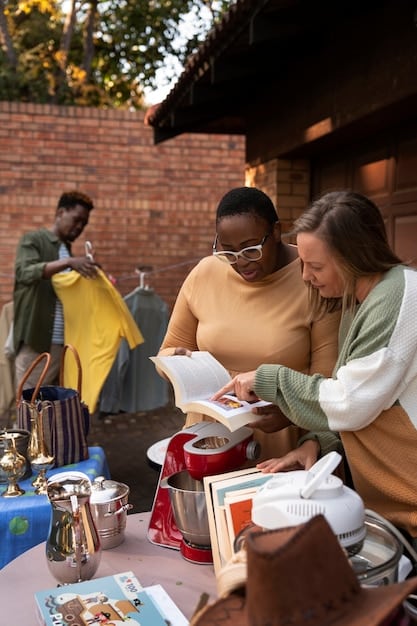
Case Studies: Early Impacts and Future Potential
While the full impact of the $5 million grant unfolds over time, early initiatives and precedent-setting projects already illustrate the transformative potential of targeted funding in archaeological preservation. Examining these initial case studies provides tangible evidence of how innovative techniques, when coupled with financial support, can yield significant advancements in protecting cultural heritage across the US.
These examples highlight the diverse applications of the grant’s aims, from leveraging advanced technology in the field to fostering crucial community partnerships. They serve as blueprints for future endeavors and underscore the profound difference that strategic investment can make in a field often constrained by limited resources. These are not just theoretical possibilities but real-world applications demonstrating tangible benefits.
Desert Uplands: Non-Invasive Mapping Revolution
In the arid desert uplands of the Southwestern US, where fragile surface sites are easily damaged, a portion of the grant has already supported a project focused on extensive non-invasive mapping. Using advanced aerial LiDAR combined with ground-penetrating radar, archaeologists were able to map an entire ancient village complex without disturbing a single stone. This approach revealed previously unknown structures and intricate water management systems, providing invaluable data without the need for extensive, often destructive, excavation.
This project not only preserved the physical integrity of the site but also demonstrated a cost-effective and efficient method for large-scale survey. The detailed 3D models generated are now being used for virtual public outreach, allowing global access to a site that remains physically protected. The success of this initiative is paving the way for similar projects in other sensitive ecosystems, setting a new standard for ethical archaeological practice.
Coastal Marshlands: Climate Change Adaptation in Action
Another significant allocation of the grant supports a pilot project in the rapidly eroding coastal marshlands of the Gulf South. Here, a significant historical settlement was at extreme risk from rising sea levels and increased storm intensity. Instead of futile attempts to build large protective barriers, the project focused on an adaptive strategy combining rapid rescue archaeology with bio-engineering.
Archaeologists meticulously excavated and documented priority areas, recovering key artifacts and data. Simultaneously, environmental scientists, in collaboration with local communities, implemented a nature-based solution using native marsh grasses and oyster reefs to naturally stabilize the shoreline and dissipate wave energy. This innovative approach offers a sustainable model for preserving cultural heritage in highly dynamic environments, showing how ecological restoration can directly contribute to archaeological preservation. The long-term monitoring of this site will provide crucial data on the effectiveness of such integrated strategies in the face of ongoing climate change, offering a viable path forward for countless other threatened coastal sites.
Challenges and the Path Forward
While the $5 million grant represents an unprecedented boost for archaeological preservation in the US, its implementation is not without challenges. Successfully transforming innovative techniques into widespread practice requires navigating complex logistical, ethical, and practical hurdles. Recognizing these obstacles is the first step toward developing robust strategies for overcoming them, ensuring that the grant’s potential is fully realized and sustained long-term.
The path forward demands continuous adaptation, collaboration, and a willingness to learn from both successes and setbacks. It’s about building enduring frameworks that can outlast the initial funding cycle and truly embed innovative preservation into national archaeological practice.
Overcoming Logistical and Operational Hurdles
Deploying cutting-edge technology and implementing new methodologies across a vast and diverse country presents significant logistical challenges. Access to remote sites, the need for specialized equipment, and ensuring consistent application of new techniques across various institutions are major considerations. Furthermore, integrating new technologies often requires substantial upfront investment in training and infrastructure, which can be a bottleneck.
Ensuring equitable distribution of grant resources is also crucial to avoid an uneven application of advanced preservation methods. Strategic planning is needed to support smaller organizations and under-resourced regions, preventing a concentration of benefits in only a few well-established institutions. Building regional hubs of expertise and sharing resources can help decentralize implementation and foster broader adoption.
Addressing Ethical and Regulatory Complexities
Innovation in archaeology must always proceed with acute sensitivity to ethical considerations, particularly concerning indigenous heritage and cultural property. The increased use of non-invasive techniques, while beneficial, still requires careful navigation of land-use rights, intellectual property, and community consent. Ensuring that data collected through new technologies benefits communities, rather than being exploited, is paramount.
Regulatory frameworks also need to evolve to accommodate new preservation techniques. Current heritage laws may not explicitly address the nuances of digital preservation, remote sensing data ownership, or innovative on-site stabilization methods. Collaborative efforts between archaeologists, legal scholars, and policymakers are essential to update regulations, ensuring they support and facilitate, rather than hinder, modern preservation efforts.
The long-term sustainability of the grant’s impact depends on creating self-sufficient models beyond the initial funding period. This involves diversifying funding sources, establishing endowments, and demonstrating the economic and cultural value of archaeological preservation to secure ongoing public and private support. Sustained public engagement, transparent reporting of outcomes, and continuous advocacy for cultural heritage will be vital in ensuring that this $5 million grant is not just a temporary boost but a foundational investment in the enduring future of archaeological preservation in the US.
| Key Preservation Focus | Brief Description |
|---|---|
| 🔬 Tech Integration | Adopting LiDAR, GPR, and 3D modeling for non-invasive site mapping and digital archiving. |
| 🤝 Community Partnerships | Empowering local and Indigenous communities in co-management and preservation efforts. |
| 🌍 Climate Resilience | Funding strategies to protect sites from sea-level rise, erosion, and extreme weather. |
| 📚 Education & Training | Investing in programs to train specialists and raise public awareness about heritage value. |
Frequently Asked Questions About Archaeological Preservation
The grant aims to revolutionize archaeological preservation in the US by funding innovative conservation techniques. Its primary goal is to protect cultural heritage sites from modern threats like climate change and development, ensuring their survival for future generations through advanced methods and community involvement.
The grant will support the use of cutting-edge technologies such as LiDAR, Ground-Penetrating Radar (GPR), and drone imagery for non-invasive site mapping and documentation. These tools help archaeologists understand and preserve sites without extensive excavation, minimizing disturbance and maximizing data collection efficiency.
Indigenous communities are central to the grant’s strategy, with a strong emphasis on meaningful partnerships and co-management. The grant supports empowering tribal nations in their own preservation efforts, recognizing their ancestral ties and traditional knowledge as vital for ethical and sustainable heritage protection.
The grant funds resilient preservation strategies, including nature-based solutions for coastal erosion, wildfire preparedness, and flood mitigation. It aims to develop long-term, adaptive plans that integrate climate science with archaeological practice to protect vulnerable sites from rising sea levels and extreme weather events.
The grant will invest in training programs, scholarships, and internships for aspiring conservation specialists, ensuring a skilled workforce. It also supports public awareness campaigns, K-12 educational curricula, and citizen science projects designed to foster broad appreciation and advocacy for archaeological heritage.
Conclusion
The new $5 million grant for archaeological preservation marks a turning point, providing critical resources for innovative techniques and a renewed focus on climate resilience and community engagement. By integrating cutting-edge technology with ethical practices and robust educational initiatives, this investment not only safeguards our past but also empowers a future generation of heritage stewards. It reflects a profound understanding that cultural preservation is a continuous, collaborative endeavor, vital for maintaining the rich tapestry of human history for all to appreciate and learn from.
